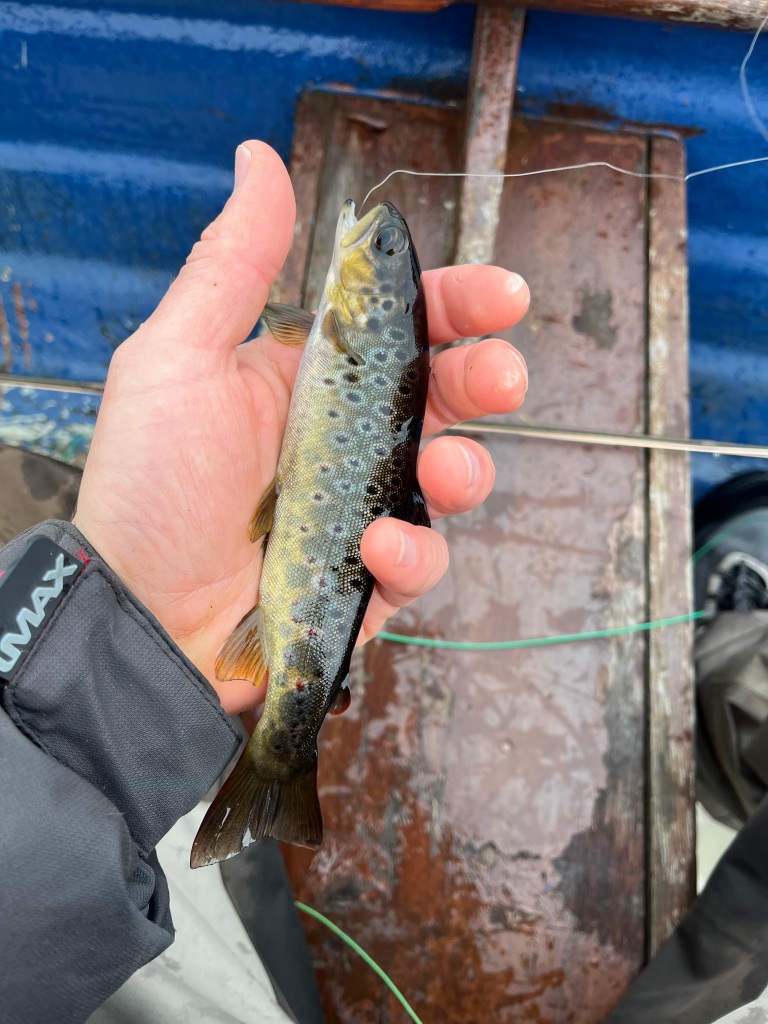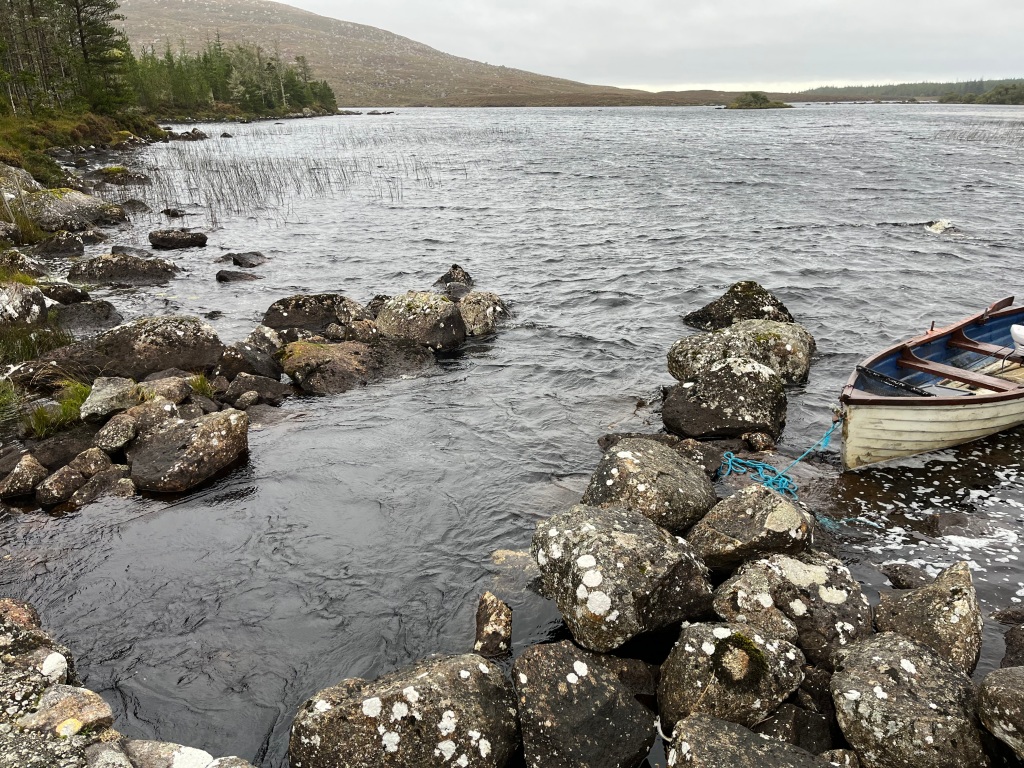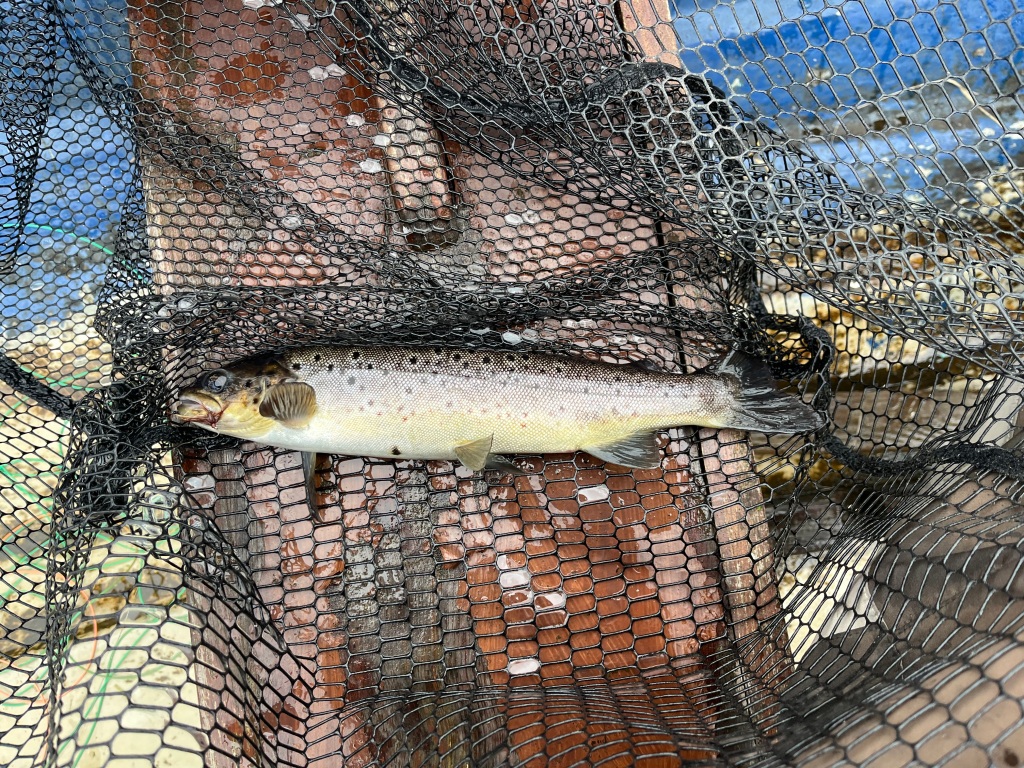
This one may be of interest to those of you who like me, have had your interest re-kindled in the glory days of sea trout fishing in Connemara. It was actually the Ireland on the Fly podcast that nurtured my interest, as being born in the late 90s, I never knew of the sport that once was in South Connemara. In the time since I have read, and re-read on multiple occasions (as have so many others) the acclaimed ‘A Man May Fish’ in which Kingsmill Moore dedicates at length an excellent section to the sea trout fishing that captured much of his angling life in the West of Ireland. Sadly, as we all know too well, the best days of sea trout fishing are a thing of the past, the collapse of the stock being owed in its entirety to the advent of open cage salmon farming in the coastal waters of Connemara. That said there are a few systems in which the white trout still cling onto their existance – the Costello & Fermoyle fishery being one of these, and so, prospecting anglers like myself still have the opportunity to tread in the footsteps of Kingsmill Moore, on the upper loughs of this once mighty fishery – Here’s how I got on.



CLOGHER
Four miles of a drive from Fermoyle lodge, through the sloping and still somewhat barren country of the Cashla one must travel, before finally coming to the Clogher track. I can only imagine the desolate moorland scene that would have greeted Kingsmill and his companions when first they reached this point – “the haunt of peregrine and raven, of wild goat and blue mountain hare…. no dwelling, no cultivation, not even a tree”. Alas, today the surrounding countryside is domineered by unsightly wind turbines and poisonous forest. The intimidating Sitka spruce, planted in uniform rows, towers high on all sides, and Clogher itself would no longer be reachable only for the old bog road has been maintained. Whatever chance you have of navigation with compass and map on an empty plain, on the forest floor clambering over upturned roots of the previous, felled generation of trees is nothing short of an impossible feat. On the track, lost deep below the on the dark, drowned floor, there is nothing. Only the distant whirring and groaning of the wind turbines break the otherwise eerie silence. There is not a whisper of wind, not the chirp of a sparrow, nor the call of a grouse. One of the last lost edens of this world is now fighting desperately for its meagre existence, against the sterile green wave of progress.
The path to Clogher though an arduous one is certainly easier to traverse now than it would have been in 1939. The forestry have gravelled most of it and you are now able to drive almost to the lake shore – something I am sure the Kingsmill did not have the luxury of. It still follows the same gradient as it did all those years ago. Past Lettercraphroe or the ‘anglers tragedy’ (the finest white trout lake never to hold white trout), though now almost completely blanketed in forestry it is visible, just, above the pronged fingers of the conifers now planted on almost all of its surrounding shorelines. Over the spur of Clogher mountain I went, and down again through a rock fall where the wild goats with immense horns and topaz eyes stare you out of countenance. Fortunately, I did not encounter such creatures though I am sure they still roam these hills, as do their white wooly counterparts, a few of which blocked my road with horns equally as immense.
After what seems an eternity, the path finally reaches an abrupt end, but not before the first glimpse of Clogher reveals itself through a narrow gap in the trees, where a boggy ravine has been let alone and a small stream oozes through the hillside seeping its way down into the lough. The final hundered yards involves a short downhill hike through the bog grasses woven together with the dew laden spider-webs, to the lakeshore. Where at once, the boat appears at a dugout in the bank.
The day in question – late in the month of September, bore itself grey and cool. The lough lay before me a dull vista of short whippy waves. A fresh south east wind gathered strength as it reared over the moraine ridge to the south, threatening to rise the white horses, though never quite achieving its feat. That is just about the only safe feature of Clogher – it’s size and littany of islands, promontaries and forested shorelines prevent any wave from reaching a dangerous height. The water is shallow, and strewn with boulders much like the surrounding country side. The peaty suspension has seeded itself deep onto the surface of the rocks below, masking them from view in even an inch of water. Great caution is needed when navigating the shallows.
I cannot better Kingsmill Moore’s description of Clogher as a fishery, though I may try and add to it. There are just two deep holes on Clogher, one just at the peninsula as you leave the dugout, and the other to the rear of the island. The rest of the lough is shallow and fair game. The judge puts emphasis on the importance of the island in dictating the fishing, and as I very quickly found the accuracy of this statement and the importance of this was not to be underestimated. Unfortunately for Kingsmill, the advent of the outboard engine had not yet come to pass, and so for me, the time lost in the passage from one half to the other along the mouth of the black river was halved, and the effort expended in the row reduced to zero.
The lake receives its water from two rivers. The Shannawona river that tumbles gently over the hillside, funnelled willingly through the stone piers that form the ‘butt’ of Clogher, and the Black river which drains a valley to the north west and enters to the west of the island. The Black ‘River’ pours almost inconspicuously over the boulder strewn hillside to the west of the lough. Fittingly named – the dark hue it takes from the peat in the hills tainting all of the precip in her watershed. For most of the year the river is lost in the crooks between the boulders, hugging her steep bedrock floor. Her presence is betrayed by murmurs alone, and marked by the naked boulders in her path, stripped bare of the heath and moss with every passing spate. In flood, the slumbering creek becomes a raging cauldron, revealing itself violently over mountainside and rock. Certainly where it enters the lake it is subjected to a particularly torturous path, appearing only where it is thrown with a vengence over the face of a boulder before disappearing from view once more, churning her black elixir out into a cove betwixed two rock pillars. Viewing from the lough, you could be forgiven for thinking the pillars that were placed there many millenia ago as a waypoint or marker, for the returning silver migrants – the gateway to their final hurdle.
The reputation of Clogher’s lower end is for holding the larger sea trout, but no salmon, and being “noticeably sulkier” than the eastern end. Of course it was the sea trout I was really here for, and so I found myself guilty of dodging about the island, and it was to the West that I would begin my day. To my pleasant surprise, the rise was ‘on’. And aside from the army of miniature brownies that were making a nuisence of themselves, I boated a couple of finnock, before a better white trout of about 1.5lbs which took the kingsmill on the point, and one fine fish of over 2lbs which completed my haul for the morning.
By 1 o’clock, the morning rise was all but over, the fish it seemed had been driven off by the now persistant rain. I took it as a sign that it was now time for me to seek some reprieve in the shelter of the island. The old rust-red lunch hut today offered a much welcome break from the elements. Lacking a suitable shelved shorline to pull a boat on, there is a rather perfectly shaped rock that functions as a pier. It is exactly the right size for one single lough boat to successfully dock alongside. Pushing the bracken and branches from the short path, there is a real mysterious and lost feel to the place. Lunch huts like the one on Clogher are found on a multitude of once famed sea trout loughs across south Connemara, all of which are in various states of disrepair. The Clogher hut however is one of the few that are still maintained, and today she certainly fulfilled her purpose. Hanging my sodden jacket up, and now relieved from the piercing wind I was able to reflect gleefully on what was a rather successful mornings fishing.






I had come to Clogher in hope more so than expectation, but the experience thus far was simply magical. I could have caught nothing and still felt as at peace and content as I did. Kingsmill Moore romanticised his relationship with the country of the Cashla and in a few short hours on that cold September morning, it was plain to see why. What with the golden brown of the withered bog grasses, interspersed with mellow shades of black and grey on the hillside. A painting drawn in one swift, rolling brush stroke. Where the leaves of the stunted sally bushes began to fade and the grizzly bracken, so stubborn all summer now crumbles to the slightest of touches. And, the white trout flashing their full autumnal banners rise from the dark waters readily to the fly.
I fished on for some of the afternoon, but the piercing wind and heavy clouds that had threatened all day to run me off the water finally drew the white flag from below the gunwales and saw me flee to the shelter of the snug dugout in the boggy banks. Not before I managed to add another couple of fine trout to the basket.
So how did my day on Clogher in 2023 fair in comparison to the mighty lake that Kingsmill fished all those years ago? Well, I may not have bettered the record catch of 36 sea trout which averaged over two pound weight, nor did I so much as stir, or see a salmon, but I did manage 6 white trout with an average weight of probably between 1.25-1.5lbs, taking into account that the smallest was about half a pound and largest would have comfortably hit the two pound mark. A catch that most wouldn’t have batted an eyelid to once upon a time, and it certainly wouldn’t stand out amongst the glory of Kingsmill Moore’s catches. But to me, a novice white trout angler, it was a chance to follow in the footsteps of the father of sea trout fishing in Connemara. A chance to live, if only for an afternoon, in the book that has captured the minds and imaginations of so many modern day fly-fishers. “Perhaps I shall fish it again, and perhaps -“




Epilogue:
Hopefully you’ve enjoyed the above piece – It’s been a minute since I’ve posted on here (about 6 years to be exact), but I’m still fishing and hopefully I’m finally finding some time to write again! So if you’ve been so unfortunate as to stumble upon my ramblings, do stay tuned for some more sporadic fishing posts that may (or may not) find their ways on here over the coming closed season!
The sea trout fishing on a number of fisheries in Connemara and the greater western region has seen a small resurgence this year (2023). This is directly linked with a number of the key notorious fish farms being left fallow, allowing the smolts to feed freely and return to their native rivers. The Costello & Fermoyle fishery alone recorded a catch of over 700 sea trout this season I am told, with a couple of 5 pounders recorded amongst them! And, I can well believe that following my little escapade on Clogher. If like me, you fancy your hand at a days fishing on any of the loughs or rivers, Brian Curran the fishery manager is very welcoming and keeps a boat on all of the loughs on the fishery. You can contact him through the Ireland West Angling website – https://www.irelandwestangling.ie/

Glad to have you back! I seem to remember that you had exams coming up, the last time you posted. I hope they went well…!
LikeLike
Hey Carl! Appreciate the comment! Didn’t realise it was that long ago since I last posted! They did in fact go very well those exams – have a couple more posts in the works so hopefully they will find their way on here over the next few weeks/months!
LikeLike
Belated congratulations then! I look forward to many more posts on your lough, river, and stream fishing adventures. I can only get over about twice a year, and have managed the mayfly only twice in 10 years, so I have to live my Irish fishing life vicariously, through others…
LikeLike